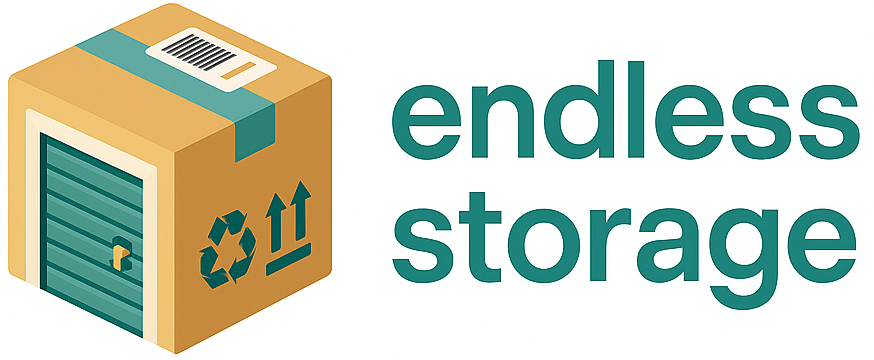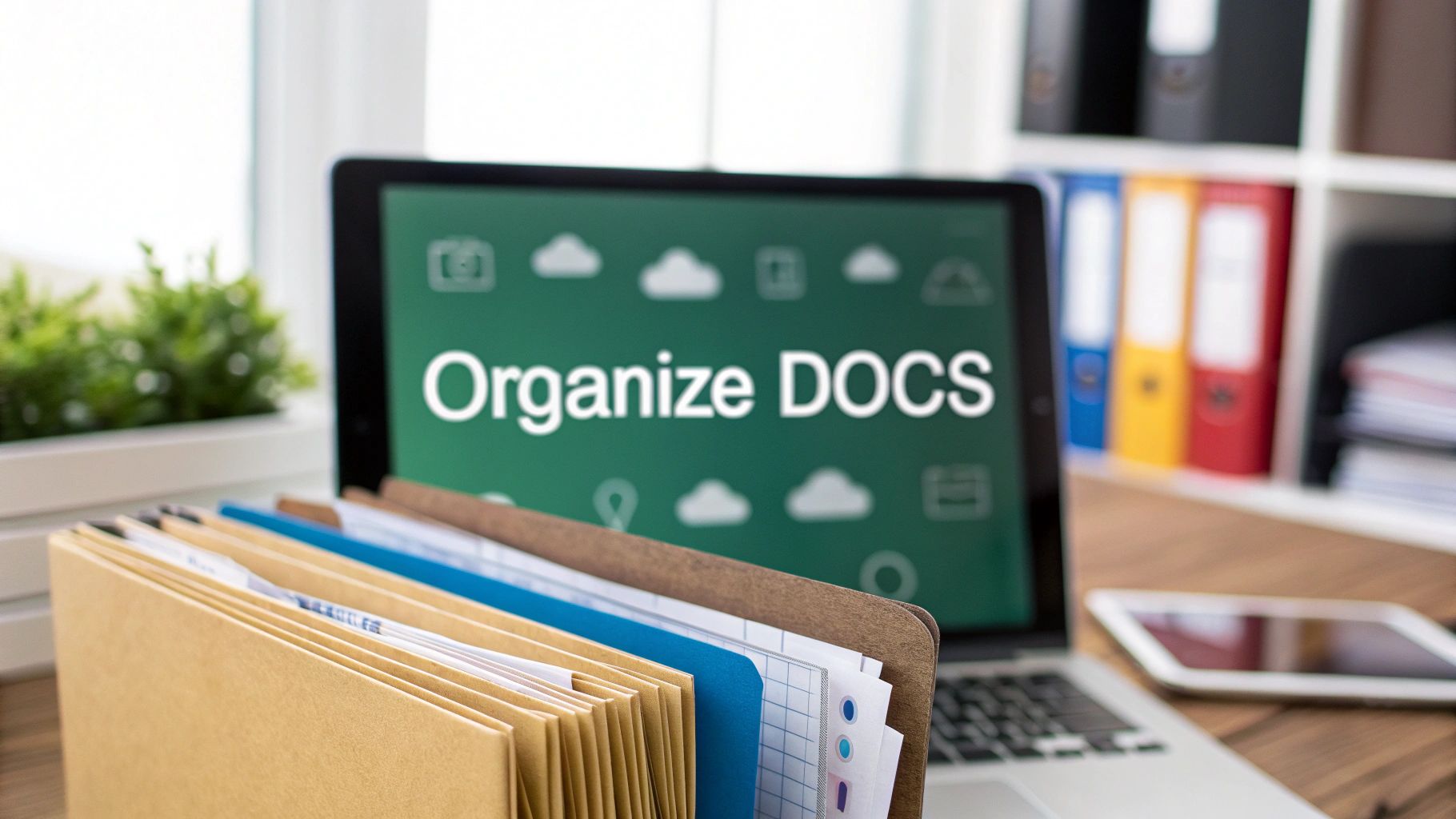Feeling buried under mountains of paper or lost in a maze of digital folders? I get it. The first step to reclaiming your space and sanity is surprisingly simple. Just sort everything into three piles: Archive (the keepers), Action (the to-dos), and Reference (the "just in case" stuff). This quick pass immediately turns that overwhelming clutter into a real, actionable plan.
Creating Your Document Organization Hub
Before you rush out to buy a single file folder or create a new digital directory, you need a command center. This is your central hub for wrangling every piece of paper and every digital file that crosses your path. It's where you'll make clear-headed decisions about what to keep, what to scan, and what to shred, setting up a system that actually sticks.
Think of it as your personal document triage station. The goal here is to get crystal clear on what an "important document" actually means for you. This covers the irreplaceable items like birth certificates and passports, but also critical records like contracts, tax returns, and property deeds.
The Initial Sorting Process
Your first sort doesn't need to be perfect or overly complicated. The "Archive, Action, Reference" method is a classic for a reason—it works.
- Archive: These are your permanent records. Think Social Security cards, wills, and academic transcripts. These need to be stored securely for the long haul.
- Action: This pile is for anything that requires you to do something. We're talking unpaid bills, forms that need your signature, or RSVPs. If you're dealing with a lot of financial paperwork, you can find great strategies for organizing invoices and streamlining your workflow that can really help.
- Reference: This is for documents you might need to look at occasionally. Think appliance manuals, old bank statements, or medical records you might need to refer back to.
Here’s a great visual that breaks down this process, showing how you can move from a chaotic pile to a clear, organized system.
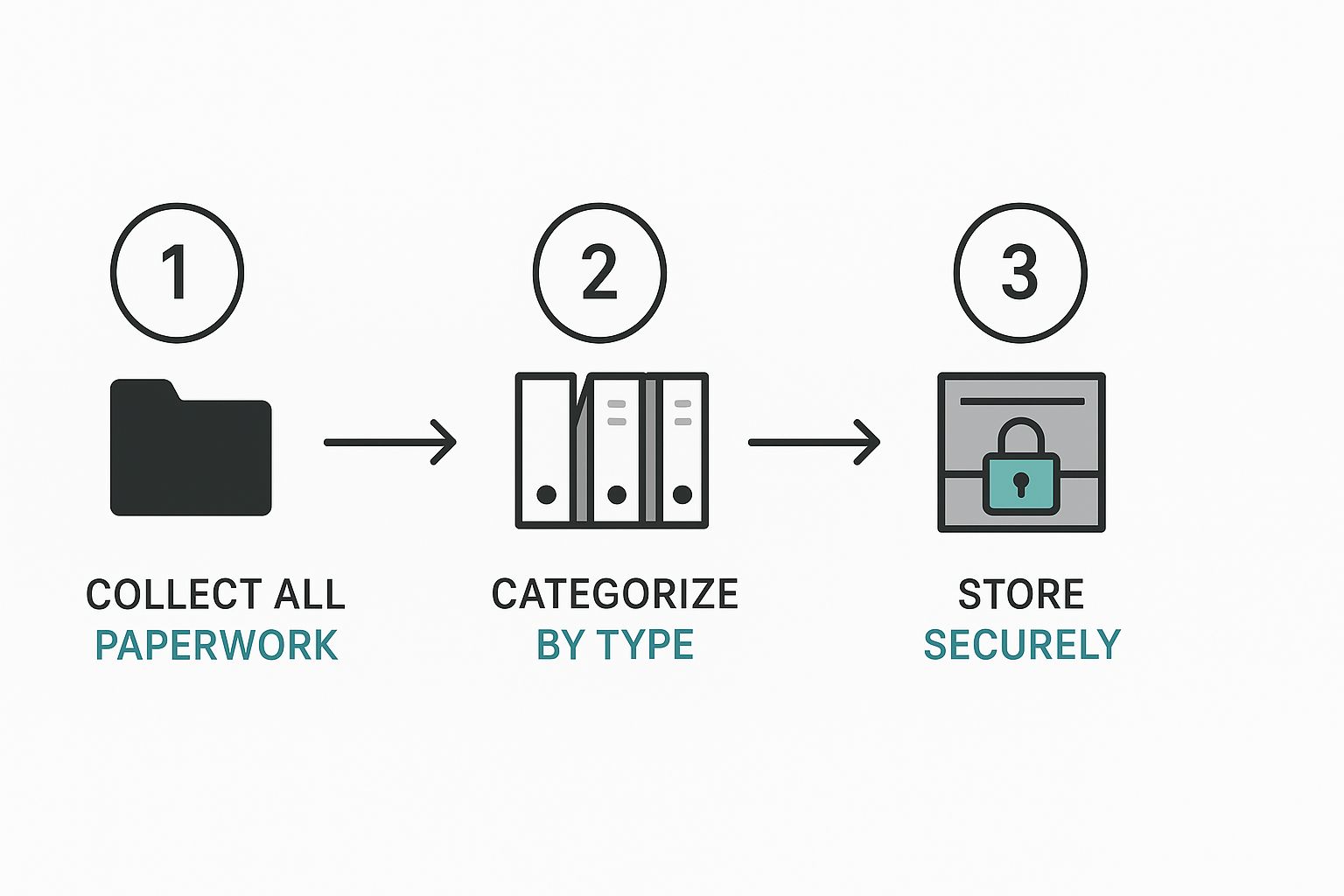
Once you've sorted your papers into these piles, the next step is getting a solid system for labeling and storing them. If you need some pointers, our guide on how to label storage bins has a ton of practical tips.
This shift isn't just a personal project; it's a global trend. The market for document management systems hit about $8.96 billion in 2024 and is expected to grow to $10.15 billion by 2025. It just goes to show you're not alone in looking for a smarter way to handle all this paperwork.
To help you get started with your own sorting, I've put together a quick reference table.
Quick-Sort Guide for Your Documents
Use this table as a cheat sheet to quickly categorize common documents and decide what to do with them.
This sorting system is the foundation of getting organized. Once you have your piles, you're ready to build a filing system—whether physical, digital, or a mix of both—that finally puts you back in control.
Designing Your Physical Filing System

Alright, you've sorted through the paper mountain. Now, where does it all live? It's time to build a permanent, accessible home for everything. This isn't just about buying a filing cabinet; it's about creating a system you'll actually use day-to-day. The best setup is one that clicks with how you think.
A simple but game-changing method I swear by is color-coding. By assigning a color to each major category of your life, you can find what you need in a split second. No more squinting at tiny labels—just grab the right color and go. Imagine green for all things financial, blue for medical, and red for household papers.
This little trick stops random papers from getting shoved into the wrong place and makes filing new documents almost automatic.
Choosing Your Core Categories
To make that color-coding system work, you need to establish a few broad "parent" categories. These will be the main buckets that hold all your specific files. The key is to keep these primary categories to a minimum to avoid overthinking where something goes.
Here’s a practical setup I’ve used for years that works for most families:
- Home: Think mortgage statements, property tax bills, home insurance policies, and major utility contracts.
- Financial: This is for bank info, credit card statements, investment records, and any loan documents.
- Medical: I keep insurance details, medical history, and receipts for each family member in their own sub-folder here.
- Auto: This holds vehicle titles, registration, insurance cards, and maintenance records.
- Personal: A catch-all for copies of vital records (like birth certificates), employment contracts, and diplomas or transcripts.
Of course, not every document belongs in a standard filing cabinet. I personally use a hybrid approach that separates documents by their level of importance.
I keep everyday reference items like appliance manuals and warranties in simple binders on a bookshelf for easy access. However, for irreplaceable documents like passports, birth certificates, and property deeds, a fireproof and waterproof safe is absolutely non-negotiable.
This two-tiered system ensures your most critical papers are protected from disaster, while the important-but-not-irreplaceable stuff remains easy to grab. Ultimately, the perfect physical filing system is one that mirrors your life's needs and your personal habits.
Building Your Digital Filing Cabinet
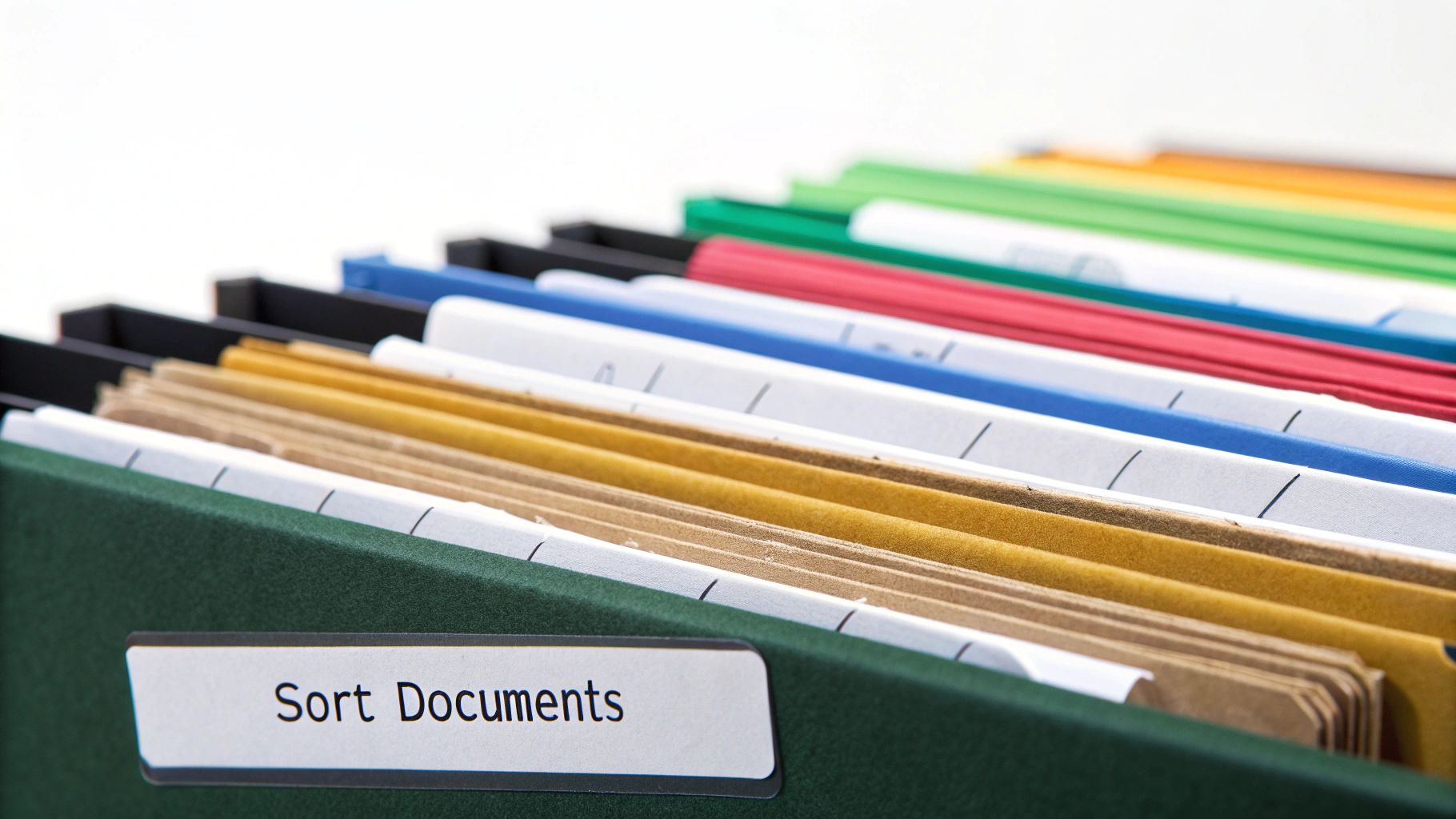
Switching from paper piles to digital files is a total game-changer. Suddenly, those stacks of clutter transform into a neat, searchable archive you can access from anywhere. The key is to build a digital filing cabinet that makes sense to you.
Think of it like setting up a physical filing cabinet. You wouldn't just toss everything into one giant drawer, right? You'd start with broad, intuitive categories. Create main folders on your computer or in the cloud for the big areas of your life: "Home," "Financial," "Medical," and "Auto" are great starting points.
From there, you can nest more specific subfolders inside. For instance, your "Financial" folder might have subfolders for "Taxes," "Bank Statements," and "Retirement." This simple hierarchy is the foundation for an organized system that prevents digital chaos.
Establish a Clear Naming Convention
Here's a pro tip that will save you countless headaches: create a consistent file naming system. Without one, even the best folder structure can become a mess. Trust me, you'll thank yourself later when you're hunting for a specific document in a hurry.
A formula I swear by is YYYY-MM-DD_Vendor_Document-Type_Details.pdf.
Let’s say you have a car insurance bill from October 2023. You'd name it something like 2023-10-15_Geico_Car-Insurance-Bill.pdf. This approach is brilliant because it automatically sorts your files by date, and you can tell what a file is without even opening it.
Choose Your Digital Tools
Alright, you've got your structure. Now, how do you get your paper documents into your new digital system?
When you’re digitizing, a technology called Optical Character Recognition (OCR) is your best friend. It’s what allows your computer to "read" the text in a scanned image, making your documents searchable. It's a core feature in most modern scanning apps and software. If you're curious about the tech behind it, you can learn more about how OCR is used for image to spreadsheet conversions to see just how powerful it is.
You have a couple of solid options for the actual scanning:
- Your Smartphone: For occasional scans, the camera on your phone and a good scanning app are surprisingly effective.
- A Dedicated Scanner: If you have a big backlog of paper to get through, investing in a document scanner with an automatic feeder is well worth the money.
Once everything is scanned, it needs a home. Cloud services like Google Drive, Dropbox, or OneDrive are perfect because they provide easy access and automatic backups. The trick is to pick one service and stick with it to keep everything in one place.
If you’re looking for a deeper dive, our guide on how to organize paperwork covers even more strategies for conquering both your physical and digital documents. https://www.endless-storage.com/blogs/how-to-organize-paperwork
This shift to digital isn't just a personal productivity hack; it's a massive global trend. The document management systems market was valued at USD 10.45 billion in 2025 and is on track to hit over USD 55.61 billion by 2037. This explosive growth shows we're moving beyond simple storage and into a new era of smart systems that use AI for advanced searching and automation.
Protecting Your Most Important Files
Having an organized system is a great first step, but it’s all for nothing if your documents are vulnerable. Once you have a handle on how to organize your files, the real work begins: making sure they're secure and can withstand anything life throws at them, from a burst pipe to a crashed hard drive.
For your most critical physical papers—think birth certificates, social security cards, passports, and property deeds—a standard filing cabinet just won't cut it. These are the documents you absolutely cannot afford to lose.
Investing in a fire-and-water-resistant safe is non-negotiable for these irreplaceable items. If you’ve got an old one you can’t get into or need a new one installed, finding a trusted locksmith for a safe is the right call. And a quick tip from experience: make sure a trusted family member or close friend knows where to find your safe and emergency binder.
Fortifying Your Digital Archive
When it comes to your digital files, protection means more than just a strong password. You need to create multiple layers of defense.
A great place to start is by enabling two-factor authentication (2FA) on all your cloud storage accounts. This adds a crucial security checkpoint, making it significantly harder for anyone else to get in. For an even higher level of security, I use file encryption tools that scramble the data, making it completely unreadable without the specific decryption key.
This proactive mindset isn't just for personal use; it's a massive trend in the business world. The global document management system market was valued at $7.16 billion in 2024 and is expected to rocket to $24.34 billion by 2032. Why? Because businesses are pouring money into secure solutions. You can actually mimic professional-grade features like encrypted storage and version control in your own system.
To make my digital life truly bulletproof, I live by the 3-2-1 backup strategy:
- Have at least three copies of your data.
- Store them on two different types of media (like an external hard drive and cloud storage).
- Keep one of those copies completely off-site (your cloud backup counts for this!).
This simple framework is your ultimate safety net. It means that even if you face a disaster like a fire, theft, or a catastrophic hard drive failure, you'll always have a way to recover your essential information. It’s about creating true peace of mind.
By putting these protective measures in place, you transform your organized archive from a simple filing system into a secure fortress. For more deep-dive tips on keeping your valuables safe, don’t miss our ultimate guide to preserving important papers.
Keeping Your System Working for the Long Haul
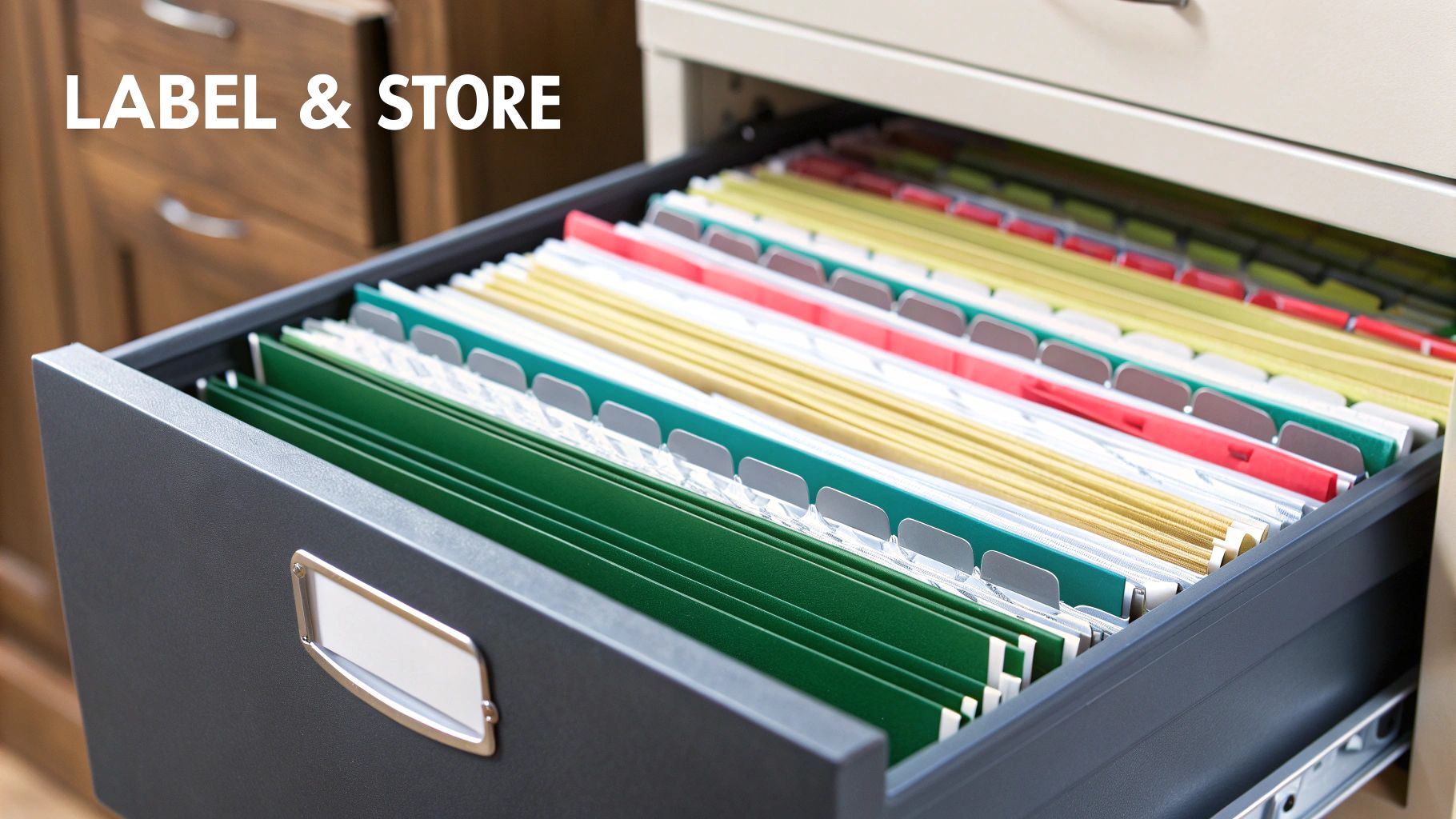
Let's be real—setting up a perfect filing system is one thing. Keeping it that way is the real challenge. The truth is, staying organized isn't a massive project you tackle once a year. It’s a habit.
The secret to avoiding a complete backslide into chaos is building simple routines that actually fit into your life. You don't need a total overhaul every few months; you just need a few solid habits.
The most powerful one I've ever adopted is the "touch it once" rule. It’s simple. When a new bill, statement, or digital download comes your way, deal with it right then and there. Don't let it sit on the counter or linger in your downloads folder. Decide its fate immediately. Is it junk? Toss it. Does it require action? Handle it, then file it away for good. This single change stops clutter before it even has a chance to start.
Build Simple Maintenance Routines
To make sure your system sticks, you need to weave small, consistent actions into your weekly schedule. This isn't about another weekend lost to sorting papers; it's about quick, focused tune-ups.
A fantastic place to start is with a 15-minute weekly "file sweep." Pick a time that works for you—maybe Sunday evening before the week kicks off—and just process everything that's come in.
In that short burst, you can:
- Scan and file any new physical documents.
- Drag, drop, and rename any new digital files into their correct folders.
- Quickly shred or delete things you no longer need, like old receipts or expired coupons.
This kind of routine is a cornerstone of a clutter-free life. For a deeper dive into making your whole space more manageable, our decluttering guide can help you transform your space and simplify your life.
Pro-Tip: For total peace of mind, create a Master Document Index. This is just a simple spreadsheet that acts as a treasure map for your most important files. List the document and its exact location. For example: "Birth Certificate - Fireproof Safe, Top Shelf." This index ensures you or your family can find any critical item in seconds, no frantic searching required.
These small, steady habits are what turn a daunting organizational project into a simple, lifelong routine.
Common Document Organization Questions
Even with the best system in place, some tricky questions always seem to surface once you get down to the business of organizing documents. Let's walk through a few of the most common hurdles I see people face, so you can build a system that truly works for you.
One of the biggest roadblocks is figuring out how long to keep everything. You definitely don’t need every scrap of paper forever, but knowing what to toss—and when—is the secret to keeping that clutter from creeping back in.
How Long Should I Keep My Files?
The fear of throwing away something important can be paralyzing. The good news is there are some clear guidelines that make this decision a lot easier. The trick is to sort your papers into two simple piles: permanent records and temporary ones.
When it comes to tax records, the standard advice is to keep them for seven years. It's rare, but an IRS audit can go back six years in certain cases, so this gives you a safe buffer. For most bank and credit card statements, hanging onto them for a year is usually fine unless you need them for business expenses or tax deductions.
But what about those truly irreplaceable documents? For things like birth certificates, Social Security cards, marriage licenses, property deeds, and wills, the answer is simple: keep them forever. These are your life's foundational papers and belong in a secure, protected spot, like a fireproof safe.
Once you’re ready to let go of old financial statements or bills, don't just toss them in the recycling. Always shred them to protect your personal information.
Are Digital Copies Legally Valid?
This is where a lot of people get confused. For most of your day-to-day paperwork—think utility bills, bank statements, and store receipts—a digital scan is perfectly fine. In fact, it's a fantastic way to slash the amount of physical paper you have to manage.
However, for some official documents, the original paper version is non-negotiable. You’ll absolutely need to keep the hard copy for:
- Vital Records: Birth, death, and marriage certificates.
- Legal Documents: Wills, trusts, and power of attorney documents.
- Property Titles: Deeds for your home and titles for your vehicles.
- Contracts: Any official agreement that required a "wet signature."
My rule of thumb is this: if you're ever in doubt, just keep the original paper version of any legal or government-issued document. Clearing out the less critical paperwork is a huge first step. If you need a little more motivation, our guide on how to declutter your home has some great tips to get you started.
And what about managing documents with a partner or family? This is where cloud storage really shines. Set up a shared folder on a service like Google Drive, agree on a simple folder structure and naming system, and you’re good to go. It’s the easiest way to keep everyone on the same page and your shared digital life just as tidy as your personal one.
Feeling overwhelmed by documents and clutter? Endless Storage makes it easy to free up space. We'll send you boxes, you pack them, and we'll store them in our secure, climate-controlled facility. Get your clutter-free life started today by visiting https://www.endless-storage.com.
Frequently Asked Questions
Unveiling the Secrets to Effortless Storage
Endless Storage is available nationwide. You pick a plan, tell us where to pickup, and we'll send a UPS van to collect, whichever state you're in.
Your shipping label will be sent to your email within a few minutes, if not instantaneously. It can also be accessed through your customer profile.
Your box will be shipped to one of our climate controlled self storage facilities in our closest self storage facility. Our manager will accept your package, notify you that your box has been received, and securely stored. Only our managers will have access to Endless Storage boxes.
Email us at admin@endless-storage.com click to live chat with us, or send us a message below.
Never! We're committed to transparent pricing with no surprises. You'll lock in your rate with no hidden fees and no long-term contracts.
Fast access guaranteed! Your boxes will arrive at your doorstep within 48 hours of requesting them back. Need to check on delivery? We provide tracking information for complete peace of mind.
Totally flexible! Store month-to-month with no long-term commitment and cancel anytime.
Everything's online! Use your account dashboard to:
• Set up automatic monthly payments
• Request box returns
• Update your address
• Order additional boxes
• Track shipments
Your boxes are insured up to $100 each. Our customer service team will help you file any necessary claims and resolve issues quickly.
Don't worry – we'll email you right away if there's a payment issue. Your items stay safe, though you may have temporary service interruption or late fees until payment is resolved.
When you request our free storage kits, you'll have 30 days to send in your boxes to activate your 3 months of free storage. Think of it like starting a gym membership – your activation window begins when you receive your kits, and your full free trial begins once you send in your first box. During your free months, you'll experience our complete storage service at no cost.
Your 30-day activation window begins when you receive your storage kits. We'll send you an email confirmation when your kits are delivered, marking the start of your activation period.
If you haven't sent any boxes for storage within your 30-day activation window, your free trial will expire and we'll begin charging the regular monthly rate of $9.99 per box. This helps ensure our storage kits go to customers who are ready to use our service.
A box costs $9.99 per month to store (plus sales tax). This price includes free shipping for standard boxes under 50 lbs. and smaller than 16"x16"x16"
Log into your Endless Storage account, locate the box you would like returned, and simply click Return My Box.
Yes, each box stored with us is insured for up to $100 throughout transit as well as the duration of storage within our facilities.
Your box will be at your doorstep within 48 hours of you requesting it back.
Store 10+ boxes? We'll pick them up for free! After your purchase, we'll contact you to schedule a convenient pickup time and arrange UPS collection.
We trust UPS with all shipments, and every box includes $100 insurance coverage. You'll receive tracking information to monitor your items' journey.
Yes! Visit any of our locations by appointment. Just bring a photo ID matching your customer profile.
For everyone's safety, we can't store hazardous materials, firearms, or perishables. All items must fit within our standard boxes.
It's easy! Order your storage kit online, and we'll ship it to you within 1-2 business days. Your shipping labels will be emailed instantly and available in your account.
We're here to help! Email us at admin@endless-storage.com, use our live chat, or send us a message through your account.
To cancel your storage service with Endless Storage, please email your cancellation request to admin@endless-storage.com. Our team will process your request within 2 business days and confirm your cancellation via email.
We understand packing takes time. However, to maintain your free trial benefits, you'll need to send at least one box within the 30-day activation window. If you need more time, you can always start with one box to activate your trial and send the rest later. You can always reach out to admin@endless-storage.com if you have any issues or concerns.
When you request our free storage kits, you're starting a 30-day window to begin using our storage service.
To avoid any charges, simply send at least one box for storage within 30 days to activate your 3-month free trial. If you decide not to use our service and don't send any boxes within the 30-day window, a one-time $50 fee will apply to cover the costs of materials and shipping. This helps ensure our storage kits go to customers who are ready to use our service.
Think of it like reserving a hotel room – we're setting aside space and sending specialized packing materials for your use. The fee only applies if you request materials but don't begin storage, similar to a hotel's no-show charge.
